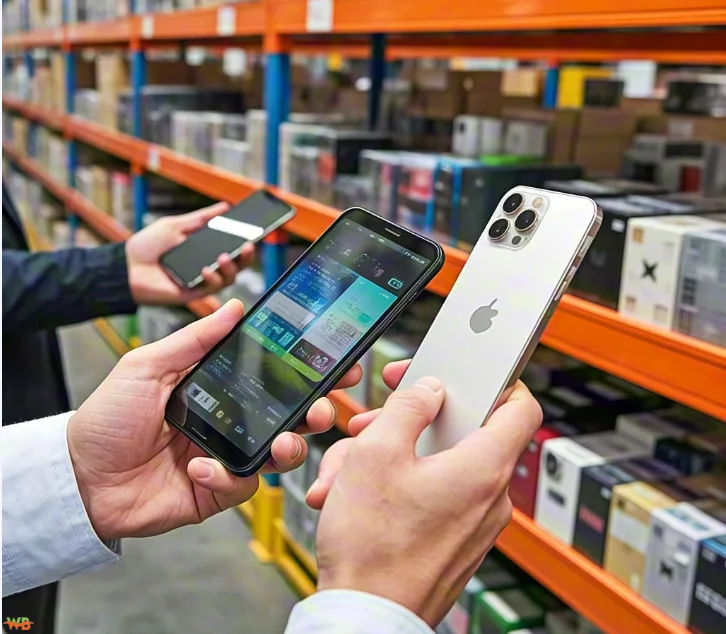Precisely controlling your supply chain, cost margins, risk management, and device inspection processes are the cornerstones of success in the highly competitive USed iPhone Wholesale market. This in-depth guide breaks down the core elements of the wholesale business.
1. Supply Chain: The Lifeblood of Wholesale Success
Choosing the right channels directly determines the stability of your supply chain, profit margins, and risk levels. Here is an analysis of the core channels:
| Channel Type | Advantages | Disadvantages | Suitable for |
|---|---|---|---|
| Official Authorized Channels | 100% genuine product guarantee, manufacturer warranty, brand endorsement, quality assurance | Extremely high entry barriers (requires becoming an Apple authorized dealer), large purchase volumes, fixed prices, strict payment terms | Large chain retailers, well-capitalized wholesalers |
| Large Distributors/National Agents | Relatively stable supply, wide coverage area, logistics support | Prices may be higher than official channels, still have qualification barriers, require strict credit checks | Regional wholesalers, medium-sized mobile phone retailers |
| Hong Kong/Overseas Channels | Price advantage (new models initially/currency fluctuations), specific versions (Hong Kong/US/Japan editions) | High risk of counterfeit/refurbished products, complex warranty terms, cumbersome customs clearance and logistics, significant legal compliance risks | Experienced wholesalers familiar with customs clearance |
| Used/Official Exchange/Resource Devices | Significant price advantage, stable market demand for cost-effectiveness | Varying quality, complex warranty processes, require strong device inspection capabilities, need a stable recycling/supply network | Specialized in the used device market, merchants with strong device inspection capabilities |
| Special Channels | (Theoretically may have extremely low prices) | Extremely high risks (counterfeit goods, fraud, legal issues), difficult to distinguish authenticity, strongly not recommended | Strongly not recommended |
Core Considerations for Selecting Channels:
- Price competitiveness: Directly impacts your profit margin.
- Supply stability and scale: Can it consistently meet your procurement needs?
- Authenticity and quality assurance: The foundation of the business, no compromise allowed.
- Warranty service: Directly impacts post-sales costs and customer satisfaction.
- Procurement barriers: Do the capital and qualification requirements align with your capabilities?
- Logistics efficiency: Impacts inventory turnover and customer delivery speed.
- Supplier reputation: The foundation for long-term cooperation, reducing risks.
II. Cost and Profit Analysis: Careful Planning is Key to Profitability
1. Core Cost Components:
- Procurement Costs: The largest expenditure. Significantly influenced by channels, models, versions, condition (used), procurement volume, and market supply and demand (e.g., new product launches). Monitor market trends closely!
- Operational Costs:
- Warehousing Costs: Rent, management fees, insurance.
- Logistics and Transportation: International/domestic freight costs, customs clearance fees (for gray market goods).
- Labor Costs: Salaries for procurement, sales, warehouse management, finance, and other staff.
- Capital Costs: Interest on procurement-related assets, opportunity costs of capital tied up.
- Marketing and Promotion: B2B platform fees, industry exhibitions, customer relationship maintenance.
- Platform Fees: Service fees/commissions for using B2B wholesale platforms.
- Taxes: Value-added tax, corporate income tax, etc.
2. Profit Margin and Strategy:
- Main Source: Wholesale-retail price difference (difference between wholesale price and sales price).
- Key Factors Affecting Profit:
- Procurement Cost Control: Identifying reliable channels with the best cost-performance ratio is a core competitive advantage.
- Sales Pricing Strategy: Flexibly setting prices based on costs, market demand, and competitive conditions.
- Operational Efficiency: Optimize processes to reduce costs related to warehousing, logistics, labor, etc.
- Inventory Turnover Rate: Faster turnover reduces capital tied up in inventory and lowers the risk of price depreciation (especially for new devices).
Typical Profit Margin Range (Highly Volatile!):
- New Domestic Models: Relatively transparent and lower, typically ranging from a few percentage points to over ten percentage points.
- Used devices/official exchange devices/specific versions: Higher potential profit margins (up to 20% or higher), but accompanied by higher quality, warranty, and legal risks.
Core Strategy Selection:
- Low-margin, high-volume sales: Profit through high turnover rates and economies of scale. Suitable for standardized products and stable channels.
- High profit margin with low turnover: Focus on premium products such as scarce versions and high-quality used devices. Requires precise product selection and risk management capabilities.
III. Risk Management: Walking on Thin Ice to Ensure Steady Progress
Wholesale Used iPhone risks are everywhere; ignoring risks is tantamount to self-destruction:
1. Supply Chain Risks (The Greatest Threat!):
- Counterfeit/refurbished/modified devices: Once sold, they may lead to customer claims, reputational damage, legal disputes, or even criminal liability.
- Version confusion/device locks: Carrier locks or regulatory locks (enterprise-customized devices) prevent normal device functionality.
- Hidden ID locks/network locks: Devices cannot be activated or have limited functionality.
- Functional defects/hidden issues: Inspection oversights lead to high after-sales costs and disputes.
2. Financial Risks:
- Inventory buildup: Ties up significant working capital, and older models may depreciate rapidly after new releases.
- Downstream payment issues: Customers default on payments or create bad debt.
- Market price fluctuations: Currency fluctuations or new releases cause significant price volatility.
3. Market Risks:
- Declining demand (economic environment, competitors).
- Policy changes (import/export, taxation, second-hand transaction regulations).
- Intensified competition leading to profit erosion.
4. Legal Compliance Risks:
- Selling counterfeit or substandard products (criminal!).
- Smuggling gray market goods.
- Infringing intellectual property rights (unauthorized sales).
- Tax issues.
5. Management Risks:
- Internal fraud.
- Logistics damage or loss.
- Process vulnerabilities.
Golden Rules of Risk Management:
- Device Inspection is Key: Establish a robust, standardized device inspection process (see Section 4), and invest in professional personnel and equipment.
- Strict Channel Selection: Only establish long-term partnerships with suppliers who have a good reputation and have undergone rigorous background checks. Reputation and industry evaluations are critical.
- Contract Protection: Sign contracts with suppliers and customers that clearly define responsibilities and contain stringent terms, specifying quality, warranty, payment, and breach of contract liabilities.
- Lean Inventory: Stockpile inventory based on sales forecasts to avoid overstocking and accelerate turnover. Remain sensitive to market changes.
- Financial Stability: Strictly manage cash flow, cautiously assess the creditworthiness of downstream customers, and control payment terms and credit limits.
- Compliance: Continuously monitor and strictly adhere to national laws and regulations regarding product quality, imports/exports, taxation, and second-hand electronic product transactions. Avoid gray areas.
- Insurance Coverage: Consider purchasing appropriate insurance, such as cargo insurance, to transfer part of the logistics risk.
IV. Device Inspection Process: A Critical Competitive Advantage (Especially for Used Devices/Non-Official New Devices)
For iPhones from non-official sources, device inspection capability is the lifeblood of wholesalers, and a watertight standardized process is essential for survival:
1. Visual Inspection:
- Strictly grade the condition according to standards: like-new, excellent, minor scratches, major scratches, cracked screen, scrap.
- 360-degree inspection: Check the body, screen, and frame for bumps, scratches, dents, or deformation.
- Key inspection points: Check for signs of tampering with screws, whether the gaps around the screen edges/back cover are uniform, and whether the sealant is intact (to determine if it has been disassembled or repaired).
2. Comprehensive Functional Testing (All Items Must Pass):
- Screen: Display solid-color images to check for dead pixels, bright spots, color spots, and uneven backlighting. Test touch sensitivity (drag icons across the entire screen).
- Buttons: Test the feel and functionality of the volume keys, mute key, power key, and Home key (if applicable).
- Camera: Take photos and record videos with the front and rear cameras (test focusing, zooming, and flash functionality).
- Audio: Test the speaker (play music), earpiece (make calls), and microphone (record audio and voice memos).
- Sensors: Test proximity sensing (screen should automatically turn off during calls), light sensing (automatic brightness adjustment), and Face ID/Touch ID (enrollment and recognition speed and accuracy).
- Wireless Features: Wi-Fi (search, connect, transfer), Bluetooth (pairing, transfer), GPS (map location), NFC (e.g., transportation card functionality).
- Cellular Network: Insert a SIM card to test signal strength, call clarity, and mobile data internet speed (4G/5G).
- Battery Health: Go to “Settings” to view the maximum capacity percentage (important reference), and use professional testing tools to check the number of charge cycles.
3. Software Deep Inspection (Reveal Hidden Issues):
- Check Serial Number/IMEI: Check warranty status, activation lock status, whether it is an official replacement device/resource device, and whether it is lost/stolen (blacklist) on the Apple official website. This is an essential step!
- Third-Party Device Inspection Tools: Use tools like iTools or Sandglass Device Inspection (connect to a computer). Check device information consistency (model, color, memory), component information (whether original or replaced), and battery data (cycle count, health). Important note: These software reports can be tampered with and should only be used as supplementary references; they cannot replace other inspections.
- Factory Reset/Flashing: This is the most effective method for detecting hidden ID locks, network locks, and regulatory locks. Must be performed! A smooth activation process after flashing is required to eliminate the risk of device locking.
4. Disassembly Inspection (Ultimate Measure, Used for Advanced/Suspicious Cases):
- Performed by experienced professional technicians.
- Inspect the motherboard: Check for repair traces (solder joints, jumper wires), water damage traces (waterproof labels turning red), or replacement of non-original parts (screen, battery, camera, etc.). Disassembly carries risks and should not be performed lightly unless necessary or there are significant concerns.
Core Requirements:
- Professional Team: Device inspection must be performed by personnel who have undergone rigorous training and have extensive experience.
- Standardized Process: Establish written SOPs (Standard Operating Procedures), with each step strictly followed and documented.
- Equipment Investment: Provide necessary testing tools (card pins, computer, device inspection software, magnifying glass, strong light, etc.).
- Accountability: Clearly define inspection responsibilities and establish a traceability mechanism.

Ton Roobprom is an experienced writer focused on practical advice across technology, business, travel, beauty, lifestyle, and home improvements. He specializes in distilling complex subjects into clear, actionable insights to help you enhance your daily life.



